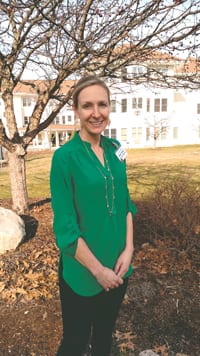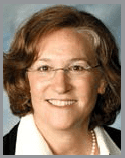Continuum of Care – Senior Living Evolves to Encompass Every Stage of Aging
Beth Vettori has sat with plenty of families stressed out from balancing their own lives with caring for an aging parent, yet reluctant to make the transition into a senior-living community.
“It’s hard for them. Usually, the sons and daughters are in their 40s, 50s, 60s, and most are still working, and it’s hard for them to play an active role in dividing those caretaking tasks,” said Vettori, executive director of Rockridge Retirement Community in Northampton.
But, while many seniors resist giving up a home they may have lived in for decades, she said, the move often goes more smoothly than expected.
“It can be hard for people to let go of where they were living — the memories, the history attached to their previous physical environment,” she told HCN. “But more times than not, we hear, ‘I should have done this years ago.’”
Kelly Sostre, executive director of Keystone Commons in Ludlow, tells a similar story. “I think, sometimes, their families see the quality of life they have here, the friends they’ve made, and they feel guilty for waiting so long.”
One of the reasons families are feeling better about making the transition has been an emphasis, in the modern senior-living complex, on a continuum of care, which gives assurance that the resident won’t have to find a new community if their physical needs change.
Keystone and Rockridge, for example, both offer independent living, assisted living, and memory-care neighborhoods, all on one campus.
“People are coming here more frail and needing more services. Five years ago, our average age was in the mid-80s; now it’s the low 90s. We’re even moving people in at 100,” Sostre said. “When we opened, the majority our independent-living folks were driving and attending social functions in the community. That’s tapered down.”
The key, then, is to offer a menu of social, culinary, and assistive options that ease the transition into this next phase of life. “We understand home is where they want to be, and if we can provide something here that’s homelike, that’s what we want to do.”
Bryan McKeever, vice president of Roche Associates, Keystone’s marketing firm, stressed that the goal is to provide supportive services that help people maintain as much quality of life and independence as possible, while receiving help with medication management and other daily activities when needed.
Linda Manor Assisted Living in Northampton, true to its name, doesn’t offer an independent-living option, but its neighbor, Linda Manor Extended Care Facility, is a skilled-nursing residence for when the time comes. “A lot of people who come to assisted living are drawn by the fact we’re on the same campus as our nursing home,” said Emily Uguccione, executive director. “As your needs change, you can age in place; the nursing home on campus really helps with that, or if you have an acute healthcare issue or have rehabilitation needs.”
Changing Needs
Linda Manor does, however, offer a memory-care neighborhood in its assisted-living complex, a draw for families who look to assisted living because they recognize the early symptoms of dementia. But the reason for making the jump can be as basic as a need for connection.
“A lot of people come to assisted living needing some socialization, and loneliness is a huge, huge factor,” Uguccione said. “It affects the psychosocial well-being of people across America.”
In addition, she said, many candidates for assisted living find they need help with activities of daily living and medication management — often, up to 10 medications a day or more.
“In assisted living, they know they’ll get their medication on time and as prescribed, and they have transportation to doctor’s appointments, errands, and social trips,” she told HCN. “And it’s not just a taxi. Our driver is a wonderful gentleman who provides support and socialization to people as he takes them to the doctor. When someone comes to assisted living, we want to give them support, but also fill in that loneliness gap.”
It’s also about safety, Vettori said. “If a loved one has some sort of deficit that puts them in a category of risk — mild dementia, cognitive decline, physical ambulation, those kind of disabilities — that’s where family members or residents look to us.
“Many times,” she went on, “people have been living independently, maybe have been in their home 30, 40, even 50 years, but now it’s getting harder to get around, especially in Western Mass., outside the large cities, where public transportation isn’t easy to access. So there’s a greater chance of isolation and a greater reliance on family.”
Those who make a complex like Rockridge their next home certainly aren’t required to socialize or engage with people, she added. “But if you take a few steps down the corridor, you’re right there with people who want to be part of your new family. That’s another great piece of living in a community setting. You have people who, for the most part, want to be there, and you can engage when you want, participate in whatever you want, and build friendships — not just with the people who live there, but also the staff.”
Sostre agreed. “They love the idea they can go to a spacious, home-like apartment they’ve decorated with their own things, yet they can be out and about at social activities and pick what they want to do every day. They have those options, and still have the comfort of their own environment, too.”
Activity planners at Keystone aren’t so much dictating a program, McKeever said, as getting to know the residents individually — what their hobbies and interests are — and developing offerings around those interests, while resident committees provide further input on the way activities are structured.
“It may well change month to month. Six months ago, I couldn’t get a card club going,” Sostre said. Since then, a beginners bridge group started up, and that activity has become hugely popular.
As the over-65 population swells, Vettori said, senior-living affordability will become an even more critical issue.
“This is going to be huge as the next group of Baby Boomers start to come online — the discrepancy between low income and high to moderate income. There’s a huge segment of the population falling through the cracks; they make too much to qualify for MassHealth or Medicaid, and don’t have enough to pay privately for a traditional independent- or assisted-living neighborhood.”
That situation inspired the development of Violette’s Crossing at Rockridge, which includes 25 independent rental apartments for people of moderate income, offering an a la carte menu of services.
“We set the income levels so that we could truly help this margin of folks that need a place to live and don’t qualify necessarily for an independent- or assisted-living community or some of the lower-income housing options,” Vettori said. “We’re one of the first across the country to pilot and put together a program like this where we’re not reliant on government funding.”
Focus on Memory
With one-third of Americans above age 85 expected to develop some form of dementia, it’s no surprise that all three facilities HCN visited offer a dedicated memory-care unit.
Uguccione said Linda Manor’s memory-support and specialized life-enrichment program is driven by the habilitation model, which focuses on where their successes are and where their strengths lie, not necessarily on how to compensate for their weaknesses.
“We also do a lot with the environmental factors. The furniture is chosen really carefully, and the staff wears certain colors in the building to promote calm and serenity.”
Vettori said complexes are starting to employ wearable GPS trackers — like pendants and watches — with memory-care residents, allowing them to move more freely in the community. “People want to participate without constraints.”
That dovetails with an overall goal of giving residents more choice, she noted, which is something families increasingly demand.
“Communities like ours are constantly exploring how we can expand our menu of offerings and provide services people are looking for. They can choose to use them or not, but we never take away their independence. We really tailor the individual programming to be resident-centric.”
Sometimes, she added, residents never really accept a senior-living facility as their new home, but simply the place they live now. “Of course, we make them as comfortable as we can, knowing their heart is still at their previous home. It’s not often, but it does happen.”
Uguccione said the idea is to lessen the burdens of daily living so residents can, well, enjoy life. “People do much better when they don’t have to worry about all these other things; they can just enjoy being with each other, making new friends, and they have more time now to take up tai chi or go out to lunch, and don’t have to worry about taking three buses to get to a doctor’s appointment.”
Grace Barone, director of Community Relations at Keystone, said it’s a lifestyle, full of hobbies and interests and friends, that brings purpose back into residents’ days and gives them reason to get up in the morning, in contrast to the loneliness they might have felt in their previous home.
It also lends quality to their visits from loved ones, she added, recalling one resident’s daughter who was pleasantly surprised to see her mother painting, something she used to love but hadn’t done in 15 years.
“They’re not worried about filling the pillbox or whether there’s food in the fridge,” Barone said. “They can just come in and spend time talking and visiting, or share a meal while mom tells them about some fabulous activity she’s done.”
In other words, it feels a lot like home.



Comments are closed.